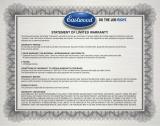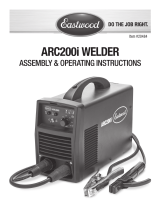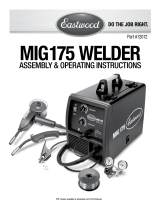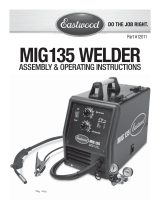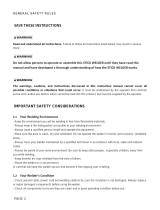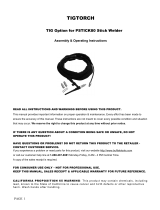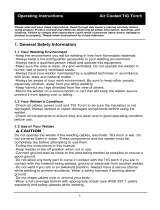Page is loading ...

ARC 80 TIG WELDING KIT
INSTRUCTIONS
Part #20358

2 Eastwood Technical Assistance: 800.544.5118 >> techelp@eastwood.com
STATEMENT OF LIMITED WARRANTY
The Eastwood Company (hereinafter “Eastwood”) warrants to the end user (purchaser) of all new welding and cutting equipment (collectively called the “products”) that it will
be free of defects in workmanship and material. This warranty is void if the equipment has been subjected to improper installation, improper care or abnormal operations.
WARRANTY PERIOD:
All warranty periods begin on the date of purchase from Eastwood. Warranty Periods are listed below, along with the products covered during those warranty periods:
3 Year Warranty on Material, Workmanship, and Defects:
• Eastwood Arc 80 Welder
Items not covered under this warranty: Collets, Collet Bodies, electrodes, nozzles, and ground clamp and cable.
All other components are covered by the warranty and will be repaired or replaced at the discretion of Eastwood.
2 Years:
• All Welding Helmets.
CONDITIONS OF WARRANTY TO OBTAIN WARRANTY COVERAGE:
Purchaser must fi rst contact Eastwood at 1-800-345-1178 for an RMA# before Eastwood will accept any welder returns.
Final determination of warranty on welding and cutting equipment will be made by Eastwood.
WARRANTY REPAIR:
If Eastwood confi rms the existence of a defect covered under this warranty plan, Eastwood will determine whether repair or replacement is the most suitable option
to rectify the defect. At Eastwood’s request, the purchaser must return, to Eastwood, any products claimed defective under Eastwood’s warranty.
FREIGHT COSTS:
The purchaser is responsible for shipment to and from Eastwood.
WARRANTY LIMITATIONS:
EASTWOOD WILL NOT ACCEPT RESPONSIBILITY OR LIABILITY FOR REPAIRS UNLESS MADE BY EASTWOOD. EASTWOOD’S LIABILITY UNDER THIS WARRANTY SHALL NOT
EXCEED THE COST OF CORRECTING THE DEFECT OF THE EASTWOOD PRODUCT. EASTWOOD WILL NOT BE LIABLE FOR INCIDENTAL OR CONSEQUENTIAL DAMAGES (SUCH
AS LOSS OF BUSINESS, ETC.) CAUSED BY THE DEFECT OR THE TIME INVOLVED TO CORRECT THE DEFECT. THIS WRITTEN WARRANTY IS THE ONLY EXPRESS WARRANTY
PROVIDED BY EASTWOOD WITH RESPECT TO ITS PRODUCTS. WARRANTIES IMPLIED BY LAW SUCH AS THE WARRANTY OF MERCHANTABILITY ARE LIMITED TO THE
DURATION OF THIS LIMITED WARRANTY FOR THE EQUIPMENT INVOLVED. THIS WARRANTY GIVES THE PURCHASER SPECIFIC LEGAL RIGHTS.
THE PURCHASER MAY ALSO HAVE OTHER RIGHTS WHICH VARY FROM STATE TO STATE.
SPECIFICATIONS
Output
Amperage
Range
Maximum
Input
Amperage
Input
Voltage
Rated
Duty
Cycle
Rod
Diameter
Rod
Material
Weight Overall
Dimensions
30-95 Amps
DC
15 Amps 120 VAC,
20 Amps 60Hz
20%
@ 95 Amps
1/16"
to 3/32"
E6013,
E7014,
E7018,
Stainless Steel
10 Lbs
[4.5kg]
12" [304mm] x 9" [229mm]
x 5" [127mm]
The Tig Welding Kit for the Eastwood Arc 80 when used with Argon shielding gas operates as a full-function TIG welder. A high
frequency start feature guarantees an instant arc strike with no Tungsten contamination. High-Frequency Inverter Technology provides
the capability of welding thin or heavy gauge steel with precision and ease.

To order parts and supplies: 800.345.1178 >> eastwood.com 3
READ INSTRUCTIONS!
Thoroughly read and understand this instruction manual before using the welder.
SAFETY INFORMATION
ELECTRIC SHOCK CAN KILL!
• Improper use of an electric welder can cause electric shock, injury and death! Read all precautions described in
this manual to reduce the possibility of electric shock.
• Do not touch any electrical components that may be live.
• Separate yourself from the welding circuit by using insulating mats to prevent contact from the work surface.
• The welder power switch is to be in the OFF position and the power supply is to be disconnected when
performing any maintenance or consumable changes.
• Always wear dry, protective clothing and leather welding gloves and insulated footwear.
• Always operate the welder in a clean, dry, well ventilated area. Do not operate the welder in humid, wet, rainy or
poorly ventilated areas.
• Be sure that the work piece is properly supported and grounded prior to beginning an electric welding operation.
• The electrode and work (or ground) circuits are electrically “hot” when the welder is on. Do not touch these “hot”
parts with your bare skin or wet clothing.
• Disconnect from power supply before assembly, disassembly or maintenance of the torch or contact tip
or changing wire spools.
• Always attach the ground clamp to the piece to be welded and as close to the weld area as possible. This will
give the least resistance and best weld.
FUMES AND WELDING GASES CAN BE DANGEROUS!
• Do not breathe fumes that are produced by the welding operation. These fumes are dangerous. Keep your head
and face out of welding fumes. Do not breathe the welding fumes
• Always work in a properly ventilated area. Wearing an OSHA-approved respirator when welding is recommended!
• Never weld coated materials including but not limited to: cadmium plated, galvanized, lead based paints.
• Refer to the MSDS (Material Safety Data Sheet) for any consumables or materials used during welding for
additional safety instructions.
WELDING SPARKS CAN CAUSE FIRE OR EXPLOSION!
• Do not operate electric arc welder in areas where fl ammable or explosive vapors are present.
• Always keep a fi re extinguisher nearby while welding.
• Use welding blankets to protect painted surfaces, dash boards, engines, etc.
• Ensure power supply has properly rated wiring to handle power usage.
• Do not use on or near combustible surfaces.
• Remove all fl ammable items within 35 feet of the welding area.
• Do not weld frozen pipes.
READ & UNDERSTAND ALL INSTRUCTIONS & PRECAUTIONS BEFORE PROCEEDING
This product emits a powerful high voltage and extreme heat which can cause severe burns, dismemberment, electrical shock and
death. Eastwood shall not be held liable for consequences due to deliberate or unintentional misuse of this product.

4 Eastwood Technical Assistance: 800.544.5118 >> techelp@eastwood.com
ARC RAYS CAN BURN!
• Use a shield with the proper fi lter (a minimum of #11) to protect your eyes from sparks and the rays of the arc
when welding or when observing open arc welding. (see ANSI Z49.1 and Z87.1 for safety standards)
• Use suitable clothing made from durable fl ame-resistant material to protect your skin. Protect nearby individuals
with a non-fl ammable barrier.
• Wear safety glasses with side shields under your welding helmet.
• If other persons are in the area of welding use welding screens to protect bystanders from sparks and arc rays.
HOT METAL WILL BURN!
• Electric welding operations cause sparks and heat metal to temperatures that will cause severe burns!
• Use protective gloves and clothing when performing any welding operations. Always wear long pants,
long-sleeved shirts and leather welding gloves.
• Make sure that all persons in the welding area are protected from heat, sparks and ultraviolet rays.
Use additional face shields and fl ame resistant barriers as needed.
• Never touch work piece until it has completely cooled.
ELECTROMAGNETIC FIELDS MAY BE DANGEROUS!
• The electromagnetic fi eld that is generated during arc welding may interfere with various electrical and electronic
devices such as cardiac pacemakers. Anyone using such devices should consult with their physician prior to
performing any electric welding operations.
• Exposure to electromagnetic fi elds while welding may have other health effects which are not known.
FLYING METAL CHIPS CAN CAUSE INJURY!
• Welding, brushing, hammering, chipping, and grinding can cause fl ying metal chips and sparks.
• To prevent injury wear approved safety glasses.
MAGNETIC FIELDS CAN AFFECT PACEMAKERS!
• Any user with a pacemaker should consult their doctor before use.
• Anyone with a pacemaker should stay away from any welding without consultant from a doctor.
SAFETY INFORMATION
NOTICE!
Do not touch the contact tip with the unit turned “ON”. Turn the unit “OFF” and unplug it before changing tips or
cleaning the nozzle.

To order parts and supplies: 800.345.1178 >> eastwood.com 5
INCLUDES
Remove all items from the box. Compare with list below to make sure
unit is complete.
• Eastwood TIG Torch with integral zippered sheath encased
10' Power Cable and 14" Shielding Gas line
• (3) Collets
• (3) Shielding Gas Nozzles, (1) #4, (1) # 5 & (1) #6
• Instruction Manual
DUTY CYCLE
The rated Duty Cycle refers to the amount of welding that can be done within an amount of time. The Eastwood Arc 80 has a Duty Cycle
of 20% at 95 Amps. It is easiest to look at your welding time in blocks of 10 Minutes and the Duty Cycle being a percentage of that 10
Minutes. If welding at 80 Amps with a 20% Duty Cycle, within a 10 Minute block of time you can weld for 2 Minutes with 8 Minutes of
cooling for the welder.
If the Duty Cycle is exceeded, the Welder will automatically shut off however the fan will continue running to cool the overheated
components. When a safe temperature has been reached, the Welder will automatically switch the welder output back on.
To increase the Duty Cycle you can turn down the Amperage Output control.
WELDER SET-UP FOR TIG TORCH KIT
Be sure the power cord is unplugged and the power switch is in the “OFF” position.
• Insert the Brass Connector of the TIG Torch Cable (Not Included) into the
Negative ( - ) Brass Receptacle on the Front Panel. Note that the Keyed Tab
of the Brass Connector fi ts into the Keyed Slot at the top of the Negative ( - )
Brass Receptacle (Fig A). Seat fully and turn 180 Clockwise to lock in place.
• Insert the Brass Connector of the Ground Cable into the Positive ( + )
Brass Receptacle on the Front Panel. Note that the Keyed Tab of the Brass
Connector fi ts into the Keyed Slot at the top of the Positive ( + ) Brass
Receptacle (Fig B). Seat fully and turn 180 Clockwise to lock in place.
• Move the “Stick”/TIG Switch to the left TIG position (Fig C).
• Attach the Ground Clamp to the workpiece as close to the welding area
as possible. To ensure good ground, clean the grounded area of any rust,
grease, oils or paint.
FIG. A
FIG. B
FIG. C

6 Eastwood Technical Assistance: 800.544.5118 >> techelp@eastwood.com
SHIELDING GAS CONNECTION FOR TIG TORCH KIT
A Shielding Gas Bottle is not included with your Eastwood ARC 80 but is necessary while TIG welding. A Shielding Gas Bottle can be
bought at most local Welding Supply Stores. Eastwood recommends the use of 100% Argon shielding gas when TIG welding Steel and
Stainless Steel.
After connecting your Shielding Gas Regulator, the gas fl ow rate needs to be adjusted so that the proper amount of Shielding Gas is
fl owing over your weld. If there is too little gas fl ow there will be porosity in your welds as well as excessive spatter, if there is too much
gas fl ow you will be wasting gas and may affect the weld quality.
• Place the Eastwood ARC 80 in its dedicated area or on a welding cart.
• Secure your Shielding Gas Bottle to a stationary object or mount to your welding cart if it is equipped to hold one so that the cylinder
cannot fall over.
• Remove the cap from the Shielding Gas Bottle.
• Thread the CGA-580 fi tting of the Argon Shielding Gas Infl ow Line into the female fi tting on the Shielding Gas Bottle.
NOTE: Do not use White Tefl on Tape on this connection as it is a tapered thread and does not require it, if you have a leak check for burrs
or dirt in the threads. If the leak persists, use gas type sealing tape.
• Tighten the fi tting with a wrench till snug, do not over tighten.
PREPARING TO TIG WELD WITH TIG TORCH KIT
TORCH ASSEMBLY/DISASSEMBLY
Assembly:
• Select a Collet body that matches your
Tungsten diameter size and thread it into
the front of the Torch.
• Select a Collet that matches your
Tungsten diameter size. Insert the
Tungsten into the Collet and put the Collet
and Tungsten back into the Torch (Fig D).
• The Gas Shielding Nozzle size should
be changed according to shielding gas
requirements for the material being
welded. Thicker materials require more fl ow. Select the correct Gas Shielding Nozzle and thread it onto the Collet body.
• Install the back cap to lock the Tungsten in place. Always make sure the Tungsten protrudes 1/8" to 1/4" beyond the
Gas Shielding Nozzle (Fig D).
Disassembly:
• Make sure the welder is turned OFF and unplugged.
• Remove the Back Cap from the Torch.
• If there is a Tungsten installed in the torch pull it out of the front of the Torch.
• Slide the Collet out of the Torch.
• Unscrew and remove the Gas Shielding Nozzle.
• Unscrew and remove the Collet body.
GAS
NOZZLE
TUNGSTEN
COLLET
BODY
COLLET
TORCH
BACK CAP
GAS
REGULATOR
KNOB
FIG. D

To order parts and supplies: 800.345.1178 >> eastwood.com 7
SHARPENING THE TUNGSTEN
To avoid contamination of the Tungsten and ultimately the weld, it is imperative to
have a dedicated grinding wheel used for Tungsten grinding only. A fi ne grit standard
6" synthetic stone grinding wheel on a bench top grinder is suffi cient or specifi cally
designed Tungsten Grinders are available.
• Shut off the welder.
• Make sure the Tungsten and Torch are suffi ciently cooled for handling then loosen
and remove the Back Cap then the Collet (Fig D) and remove the Tungsten from
the FRONT of the Torch only. (Removing from the rear will damage the Collet).
• If the Tungsten is used and the end is contaminated, use pliers or a suitable tool
to grip the Tungsten above the contaminated section and snap off the end of the
Tungsten.
• Holding the Tungsten tangent to the surface of the grinding wheel, rotate the
Tungsten while exerting light pressure until a suitable point is formed (Fig E).
• The ideal tip will have the length of the conical portion of the sharpened area at
2-1/2 times the Tungsten rod diameter (Fig F).
• Replace the Tungsten in the Collet with the tip extending 1/8"-1/4" beyond the
Gas Shielding Nozzle, then re-tighten the Back Cap (Fig G).
FIG. E
FIG. F
FIG. G
TIG WELDING WITH TIG TORCH KIT
IMPORTANT NOTE:
These instructions are intended only to provide the user with some familiarity of the
Eastwood ARC 80. TIG welding is a highly complex procedure with many variables. If
you have no experience with TIG welding; it is extremely important to seek the advice
of someone experienced in TIG welding for instruction, enroll in a local technical
school welding course or study a comprehensive how-to DVD and obtain a good
quality reference book on TIG welding as there is a moderate learning curve necessary
before achieving profi ciency in TIG Welding. Before attempting to use this unit on
an actual project or object of value, practice on a similar material as there are many
variables present and settings required when TIG welding different metals such as
steel and stainless steel. It is also strongly recommended that the user adhere to the
American Welding Society guidelines, codes and applications prior to producing welds
where safety is affected.
• Turn the Power Switch to the ON position (Fig H).
• Slowly open the gas cylinder valve.
NOTE: Always open valve fully to avoid shielding gas leakage.
• Adjust the gas regulator to 15-20 cfm.
• Grounding is very important, place the Ground Cable Clamp on a clean, bare area
of your work piece as close to the welding area as possible to minimize the chance
of shock. Scrape, wire brush, fi le or grind a bare area to achieve a good ground to
assure safety.
• Use a dedicated stainless steel brush or fl ap-disc to clean the areas to be
welded. Do not use the brush or fl ap-disc for any other purpose.
FIG. H

8 Eastwood Technical Assistance: 800.544.5118 >> techelp@eastwood.com
• Making sure all your safety gear is in place (Welding Mask, Welding Gloves,
non-fl ammable long sleeve apparel) and the area is completely free of
fl ammable material.
• Although it is a matter of developing a personal style, a good starting point
for best results is achieved by holding the tip at a 45° angle backward and
approximately 20° to the right of the weld. Hold the Filler Metal Rod at a 60°
angle to the Tungsten Tip. Must Scratch Start, (lightly touch surface to get arc
started). Before Scratch Start, open gas knob on torch (FIG I). Never allow the
tungsten tip to touch the weld puddle or material rod, while welding. Doing so
will quickly destroy the tip and contaminate the weld. If this happens, remove
the Tungsten and regrind the tip. It is best to hold the Tungsten tip 1/8" from
the surface.
• With your Welding Shield and all safety gear in place, practice “Forming a
Puddle” with the Tungsten Tip. Once you become familiar with this step.
Practice the “Dip and Pull” technique with the Filler Metal Rod and Torch. “Dip and Pull” is the practice of forming a puddle,
moving the torch while maintaining the puddle and adding fi ller rod metal to the puddle by “dipping and pulling” as you go; being
careful not to allow the Tungsten to contact the puddle or rod.
• To stop welding, pull the Tip back over the weld approximately 1/2" [13mm] then lift to break the arc. Keep shielding gas fl ow in
place for approximately 10 seconds.
• Keep in mind that you MUST let the shielding gas fl ow over the weld for approximately 10 seconds. Failure to do so will allow the
welded area to oxidize as it cools, compromising the weld integrity.
• Constantly be aware that TIG welding quickly generates heat in the work piece and torch. Severe burns can quickly occur by
contacting hot metal pieces.
• When done, shut off the Power Switch, close the Regulator in the Torch Handle then close the Shielding Gas Tank valve
completely.
GAS
REGULATOR
KNOB
CLOSE
OPEN
FIG. I

To order parts and supplies: 800.345.1178 >> eastwood.com 9
TROUBLESHOOTING
PROBLEM CAUSE CORRECTION
Arc is triggered but will not start
Incomplete Circuit
Check Ground connection. Make sure
that the ground is on a freshly cleaned
surface and close to the welding area. It
is suggested to weld towards the ground
connection.
Incorrect Tungsten
Consult chart for proper Tungsten for the
base metal being welded. In most cases
Thoriated will be used for all steels.
No shielding gas
Make sure the shielding gas cylinder is
turned all the way open and set at the
correct fl ow rate.
PROBLEM CAUSE CORRECTION
Arc wanders and it is hard to
concentrate heat in a specifi c area
Poorly prepped Tungsten Follow guidelines for prepping Tungsten.
Poor Gas Flow
Adjust the fl ow rate of the shielding gas (refer
to settings chart). Check for loose fi ttings
where gas could be leaking.
Contaminated Tungsten
Remove Tungsten from torch and break off
contaminated section and re-sharpen.
Incorrect arc length
Make sure the Tungsten is held 1/8" to 1/4"
off the work piece.
Incomplete circuit
Check Ground connection. Make sure that the
ground is on a freshly cleaned surface and
close to the welding area. It is suggested to
weld towards the ground connection.
Contaminated base metal
Clean base metal making sure to remove
any oil, debris, coatings, or moisture. If base
metal is aluminum make sure all of the oxide
is removed using either a dedicated stainless
brush or fl ap wheel.

10 Eastwood Technical Assistance: 800.544.5118 >> techelp@eastwood.com
TROUBLESHOOTING
PROBLEM CAUSE CORRECTION
Porosity in weld bead
Poor Gas Flow
Adjust the fl ow rate of the shielding gas.
Check for loose fi ttings where gas could
be leaking.
Contaminated fi ller metal
Clean fi ller metal making sure to remove
any oil, debris, or moisture.
Contaminated base metal
Clean base metal making sure to remove
any oil, debris, coatings, or moisture.
Poor Shielding
Make sure to be in an area with no wind and
with any fans turned off. Wind or fans will
blow the shielding gas away from the weld
causing porosity.
Incorrect Tungsten
Exposure
Adjust the Tungsten so that 1/8" to 1/4"
protrudes from the Collet.
PROBLEM CAUSE CORRECTION
Contamination in weld bead
Contaminated Tungsten
Adjust the fl ow rate of the shielding gas.
Check for loose fi ttings where gas could
be leaking.
Contaminated Filler Metal
Clean fi ller metal making sure to remove
any oil, debris, or moisture.
Contaminated Base Metal
Clean base metal making sure to remove any
oil, debris, coatings, or moisture. If base metal
is cold rolled steel make sure to remove any
mill scale.

To order parts and supplies: 800.345.1178 >> eastwood.com 11
TROUBLESHOOTING
PROBLEM CAUSE CORRECTION
Melting Tungsten
Poor Gas Flow
Adjust the fl ow rate of the shielding gas.
Check for loose fi ttings where gas could
be leaking.
Wrong Size Tungsten
Increase Tungsten diameter. Refer to chart
for proper sizing.
Incorrect Shielding Gas Only use 100% Argon when TIG Welding.
PROBLEM CAUSE CORRECTION
Poor Penetration
Low Voltage
Voltage setting is too low for material/
thickness. Increase as needed.
PROBLEM CAUSE CORRECTION
Tungsten Contaminated
Contact of Tungsten with
Base Metal
Keep Tungsten 1/8" to 1/4" from the base
metal. If Tungsten comes in contact break off
end and resharpen immediately..
PROBLEM CAUSE CORRECTION
Poor Weld Appearance
Incorrect positioning
The angle between the fi ller metal and the
torch must be less than 90° otherwise the
fi ller metal will prematurely melt and glob off
causing poor weld appearance.
PROBLEM CAUSE CORRECTION
Crater in the End of the Weld Bead
Insuffi cient Shielding
Keep the torch on the base metal while the
post fl ow shielding gas fl ows to protect and
cool the metal and Tungsten.
Not Enough Filler Material
Reduce current and add more fi ller at end of
weld. It may also be benefi cial to back step
to ensure no crater will form.

© Copyright 2015 Easthill Group, Inc. 2/15 Instruction part #20358Q Rev 0
If you have any questions about the use of this product, please contact
The Eastwood Technical Assistance Service Department: 800.544.5118 >> email: techelp@eastwood.com
PDF version of this manual is available online >> eastwood.com/20358manual
The Eastwood Company 263 Shoemaker Road, Pottstown, PA 19464, USA
US and Canada: 800.345.1178 Outside US: 610.718.8335 Fax: 610.323.6268 eastwood.com
TROUBLESHOOTING
PROBLEM CAUSE CORRECTION
Weld Bead is Cracking
Too much heat in material
Reduce heat and allow more time between
passes.
Base Metal is absorbing
too much heat
Preheat base metal (consult welding codes
for requirements)
Incorrect Filler Wire
Use appropriate fi ller wire type and diameter
for the joint being welded.
PROBLEM CAUSE CORRECTION
Material is Warping
Insuffi cient Clamping
Clamp work piece tightly and weld while
clamps are in place.
Insuffi cient Tack Welds
Add more tack welds until rigidity and
stiffness is developed.
Too Much Heat in Material
To reduce heat it is best to spread the welding
out around the area. This can be done by
using stitch welding techniques, alternating
sides, and/or taking your time and allowing
the pieces to cool between passes.
ACCESSORIES
TIG WELDING SUPPLIES:
#12253 – ER70S-2 TIG Wire 1/16-36" #12463 – 308L Stainless TIG Wire 1/16-36"
#12254 – ER70S-2 TIG Wire 3/32-36" #12464 – 308L Stainless TIG Wire 3/32-36"
WELDING ACCESSORIES:
#19055A – Flap Disc 60 Grit 4.5" Diameter 7/8" Hole #51139 – Copper 3 x 3 Welders Helper Set
#12590 – Welding Gloves Large #50739 – Master Welder’s Helper Panel Holding Kit
#12589 – Welding Gloves Medium #12762L, XL, XXL – Welding Jacket
#13203 – Auto Darken Welding Helmet #21524 – TIG Welding Basics DVD by Ron Covell
#13212 – Large View Auto Darken Welding Helmet #11616 – TIG Welder Cart
#19079S – Stainless Steel Brush
/

